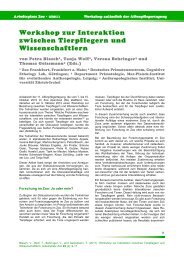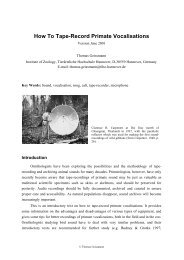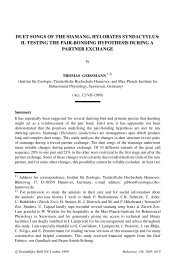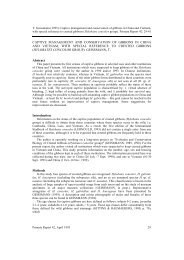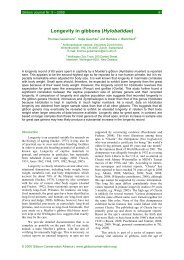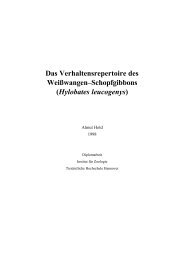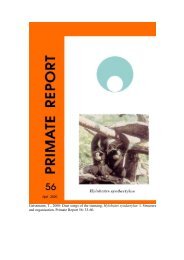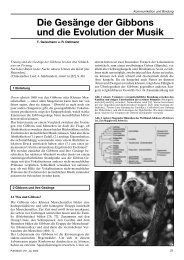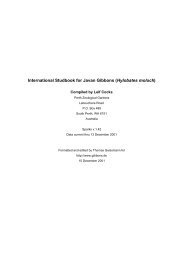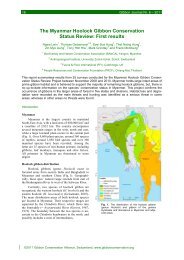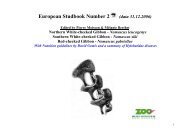The male song of the Javan silvery gibbon (Hylobates moloch)
The male song of the Javan silvery gibbon (Hylobates moloch)
The male song of the Javan silvery gibbon (Hylobates moloch)
- No tags were found...
Create successful ePaper yourself
Turn your PDF publications into a flip-book with our unique Google optimized e-Paper software.
18 T. Geissmann et al. – <strong>The</strong> Male Song <strong>of</strong> <strong>the</strong> <strong>Javan</strong> Silvery Gibbon<strong>the</strong> main <strong>song</strong> phase is longer and amounts to 2notes/phrase. This value may increase, however,to averages <strong>of</strong> up to 5 notes / phrase in some parts<strong>of</strong> <strong>the</strong> <strong>song</strong> or in some individuals.<strong>The</strong> number <strong>of</strong> notes per phrase most stronglyincreases early in <strong>the</strong> <strong>song</strong> bout (i.e. during <strong>the</strong>first 150-400 notes). <strong>The</strong> initial increase in <strong>song</strong>motivation may not be steady, and non-regularfluctuations <strong>of</strong> <strong>song</strong> motivation can occurthroughout <strong>the</strong> whole <strong>song</strong> bout.<strong>The</strong> frequency <strong>of</strong> some note types are significantlycorrelated with <strong>song</strong> motivation, but none<strong>of</strong> <strong>the</strong>se correlations are consistent across ourstudy <strong>male</strong>s (see Table 5), again suggestingindividual preferrences.Some <strong>of</strong> <strong>the</strong> <strong>song</strong> bouts we studied were notcompletely tape-recorded. As none <strong>of</strong> <strong>the</strong>mexhibits <strong>the</strong> increase <strong>of</strong> motivation, which istypical <strong>of</strong> <strong>the</strong> introductory phase, <strong>the</strong> introductoryphase <strong>of</strong> <strong>the</strong> <strong>song</strong> bout was apparently missedwhen <strong>the</strong> recording was carried out. This probablyexplains why we found fewer significant correlationsbetween note types and <strong>song</strong> motivationin <strong>the</strong>se <strong>song</strong> bouts. Obviously, incomplete <strong>song</strong>bouts should not be used when calculating thistype <strong>of</strong> correlation.Because <strong>of</strong> <strong>the</strong> high variability within <strong>male</strong><strong>song</strong>s <strong>of</strong> H. <strong>moloch</strong>, it is difficult to recogniserecurrent patterns. In contrast to <strong>the</strong> fe<strong>male</strong> greatcalls, <strong>male</strong>s produce much less stereotyped <strong>song</strong>phrases. Yet, all study animals appear to useindividually-preferred note sequences in <strong>the</strong> main<strong>song</strong> phase (see Table 6). <strong>The</strong> Halimun <strong>male</strong>, forinstance, prefers <strong>the</strong> note sequence B2 B3 B3 B3in his phrases. <strong>The</strong> Munich <strong>male</strong>, on <strong>the</strong> o<strong>the</strong>rhand, prefers B3 C B3 B3 B3, and <strong>the</strong> Jakarta<strong>male</strong> 2 prefers C C C C C.IndividualitySongs <strong>of</strong> individual <strong>male</strong>s differ significantlyamong each o<strong>the</strong>r in <strong>the</strong> note types <strong>the</strong>y use and inhow <strong>of</strong>ten <strong>the</strong>y use <strong>the</strong>m, both during <strong>the</strong> introductoryphase and <strong>the</strong> main phase <strong>of</strong> <strong>the</strong>ir <strong>song</strong>bouts. Differences are particularly common in <strong>the</strong>different types <strong>of</strong> chevron notes (type C). Inaddition, all study animals appear to exhibit individualpreferrences for note sequences in <strong>the</strong> main<strong>song</strong> phase.Our evidence for individuality should be regardedwith caution, however, because our samplesconsist <strong>of</strong> only one <strong>song</strong> bout for most study<strong>male</strong>s. <strong>The</strong>refore, <strong>the</strong> significant differences innote repertoire and phrase composition could havebeen influenced by differences in <strong>the</strong> behaviouralcontext <strong>of</strong> <strong>the</strong> <strong>song</strong>s or <strong>the</strong> emotional state <strong>of</strong> <strong>the</strong>singers, although no such differences were obviousto us. To properly demonstrate individualitywould require to find specific characteristicsconsistently occurring in several <strong>song</strong> bouts <strong>of</strong>each <strong>male</strong>. This appeared to be <strong>the</strong> case in <strong>the</strong>multiple <strong>song</strong> bouts we analysed <strong>of</strong> two <strong>of</strong> ourstudy <strong>male</strong>s (3 <strong>of</strong> <strong>the</strong> Munich <strong>male</strong> and 2 <strong>of</strong> <strong>the</strong>Jakarta 1 <strong>male</strong>).Comparison with <strong>male</strong> singing in o<strong>the</strong>r <strong>gibbon</strong>s<strong>The</strong> frequency <strong>of</strong> singing varies between populationsand may be influenced by variables, suchas population density, availability <strong>of</strong> resources,sexual activity and wea<strong>the</strong>r. Yet, roughly, most<strong>gibbon</strong> species duet almost daily (Leighton, 1987),except siamangs which duet about one day inthree (Gittins and Raemaekers, 1980). Among <strong>the</strong>non-duetting <strong>gibbon</strong> species, <strong>male</strong> Kloss’s<strong>gibbon</strong>s sing almost daily (Whitten, 1982), whereasmost <strong>male</strong> <strong>silvery</strong> <strong>gibbon</strong>s appear to sing onlyrarely, about once a week (Geissmann and Nijman,2001). We cannot confirm Kappeler’s(1984a) conclusion that mated <strong>male</strong>s <strong>of</strong> H. <strong>moloch</strong>do not sing, because <strong>the</strong> Munich, Howletts 2 andHowletts 3 <strong>male</strong>s <strong>of</strong> this study were mated. Yet,<strong>the</strong> <strong>silvery</strong> <strong>gibbon</strong> appears to be exceptionalamong all <strong>gibbon</strong> species because <strong>of</strong> <strong>the</strong> rarity <strong>of</strong>its <strong>male</strong> singing.In all examined <strong>gibbon</strong> species (e.g. H. klossii,H. lar, N. leucogenys) <strong>male</strong> <strong>song</strong> bouts usuallybegin with simple, single notes. During <strong>the</strong> course<strong>of</strong> <strong>the</strong> <strong>song</strong> bout, additional, more complex notetypes are included and <strong>the</strong> phrases become longerand more complex (Schilling, 1984; Tenaza, 1976;Whitten, 1980, 1982; Raemaekers, Raemaekersand Haim<strong>of</strong>f, 1984). In this respect, <strong>the</strong> <strong>male</strong> <strong>song</strong><strong>of</strong> H. <strong>moloch</strong> corresponds to that <strong>of</strong> <strong>the</strong> o<strong>the</strong>rspecies.Male <strong>song</strong>s <strong>of</strong> many <strong>gibbon</strong> species such asH. klossii (Tenaza, 1976; Whitten, 1980, 1982), allspecies <strong>of</strong> <strong>the</strong> genus Nomascus (Schilling, 1984,Geissmann, unpublished data) and Symphalangussyndactylus (Geissmann, unpublished data) producerelatively stereotyped phrases exhibiting amoderate variability both within and between individuals.Figure 8 shows several sonagrams documenting<strong>the</strong> repetitive structuring <strong>of</strong> <strong>the</strong> <strong>male</strong> <strong>song</strong>in H. klossii and N. leucogenys. Not only do individual<strong>male</strong>s <strong>of</strong> <strong>the</strong>se species repeat <strong>the</strong>ir phrases



